Spectrometer Educational Kits
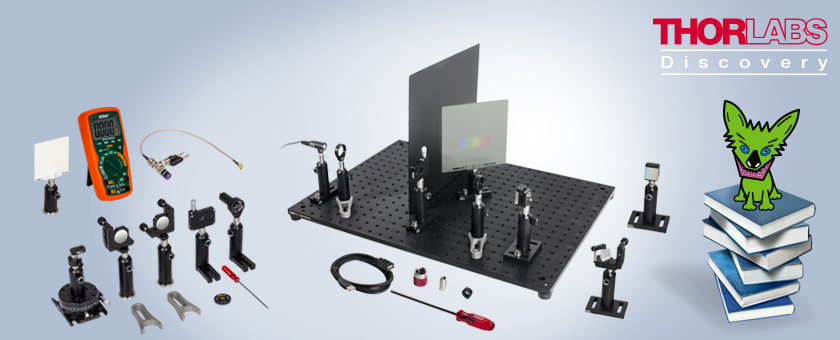
- Designed for Education, Demonstration, & Classroom Use
- Easy-to-Use Kits Include Components Plus
Free Educational Materials
EDU-SPEB2/M
Spectrometer Kit
EDU-SPEBCT1/M
Czerny-Turner Extension Kit

Please Wait
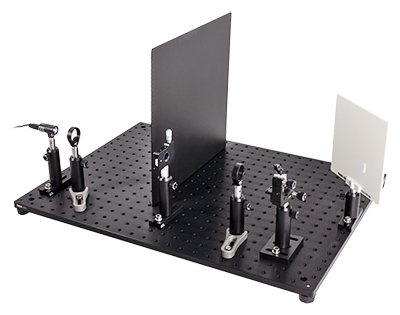
Click to Enlarge
EDU-SPEB2/M Educational Kit Showing the Spectrum of a White Light LED Source
Spectrometer Educational Kits
- Designed for Educational, Demonstration, and Classroom Use
- Includes Extensive Manuals for Easy Assembly and Use
- Choose from Educational Kits Containing Imperial or Metric Components
Spectrometer Kit Details
- Build a Grating-Based Spectrometer with 600 lines/mm or 1200 lines/mm Reflective Gratings
- Build a Prism-Based Spectrometer with an Equilateral Dispersing Prism
- Study the Spectral Makeup of the Included White LED or Various User-Provided Light Sources
- Separate Czerny-Turner Extension Kit Available for Absorption Spectroscopy
Thorlabs' EDU-SPEB2(/M) Spectrometer Educational Kit includes the components to build a grating-based or dispersing prism-based spectrometer. This educational kit is offered in both an imperial and metric version. Although grating- and prism-based spectrometers can both be used to observe the spectra of various light sources, they function using very different physical principles. The grating spectrometer provides insights into interference and the wave nature of light, while the prism spectrometer provides the opportunity to study various ray optics concepts, such as an optical material's index of refraction and dispersion.
Also available is the EDU-SPEBCT1(/M) Czerny-Turner Extension Kit, which modifies the spectrometer setup to closely resemble the optical geometry used in commercial units. This setup can be used to perform quantitative absorption spectroscopy measurements. Note that this kit is not a standalone kit and parts from the EDU-SPEB2(/M) Spectrometer Kit are required to construct the complete setup. See the Kit Components tab for a full list of the included components in each kit.
Thorlabs Educational Products
Thorlabs' educational line of products aims to promote physics, optics, and photonics by covering many classic photonics experiments, as well as emerging fields of research. Each educational kit includes all the necessary components and a manual that contains both detailed setup instructions and extensive teaching materials. These lab kits are being offered at the price of the included components, with the educational materials offered for free. Technical support from our educational team is available both before and after purchase.
Purchasing Note: Both English and German language manuals/teaching information are available for our educational kits. The imperial and metric versions of the kit include the English manual. For the metric kits, a German language manual will be added based on your shipping location. Please contact Tech Support if you would like the German manual included with the imperial version of the kit. As with all products on our website, taxes are not included in the price shown below.
The EDU-SPEB2(/M) Educational Spectrometer Kit includes all of the components necessary to build a grating-based or dispersing prism-based spectrometer, including two diffraction gratings with different groove densities (600 lines/mm and 1200 lines/mm) and an equilateral dispersing prism. Either imperial or metric versions are available. LEDs, lasers, gas discharge tubes, light bulbs, and many other light sources can all be analyzed with this kit. A white LED and a bandpass filter are included. The LED is a spectrally broad light source, which in combination with the bandpass filter can also provide a narrow spectral line.
Grating-Based Spectrometer
The grating-based spectrometer uses a reflective ruled diffraction grating to separate the spectral components of light. As seen in the photo to the right, the light is focused on an adjustable slit using one focusing lens. The light exiting the slit passes through another lens and is incident on a diffraction grating. Light is diffracted off of the grating and is incident on the viewing screen. Since the angle of diffraction is wavelength dependent, light diffracting off of the grating is separated into different wavelengths and appears at different locations on the screen. Both emission line and broadband sources can be analyzed, and the wavelength of spectral components can be calculated.
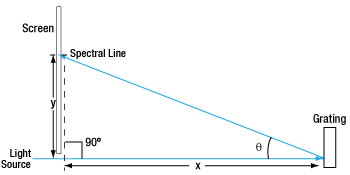
Click for Details
A drawing illustrating how students can determine θk by measuring the location of a spectral line.
The experiment is set up so that the simple grating equation can be used:

where θk is the angle at which the light incident on the grating leaves the grating, k is the diffraction order, λ is the wavelength of the light forming the spectral line, and g is the groove density of the grating. Students can calculate θk by measuring the distance between the grating and the plane of the slit and the distance between the light path entering the slit and first order spectral line, as shown in the figure to the left. They can then use this number to determine the wavelength of the spectral lines visible on the screen.
Additionally, the interference properties of the diffraction grating can be studied with this spectrometer.
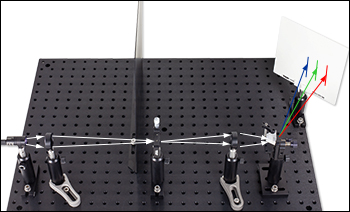
Click for Details
Prism-Based Spectrometer Setup
Prism-Based Spectrometer
The prism-based spectrometer uses an equilateral dispersing prism to separate the spectral components of light. As seen in the photo to the right, light is focused on an adjustable slit using one focusing lens. The light exiting the slit passes through another lens, which focuses it onto the viewing screen after passing through the equilateral dispersing prism. Light of different wavelengths is refracted at different angles through the prism, so the light is separated into its spectral components when viewed on the screen. As with the grating-based kit described above, both emission line and broadband sources can be analyzed.
Additionally, the refractive properties of the prism can be studied. For example, the index of refraction of the prism can be found by measuring the angle of minimum deviation. The angle of minimum deviation is represented by γ in the figure to the lower left. It is defined as the angle between the light entering and exiting the prism when the light passing through the prism is parallel to the prism's base. For the prism used in this experiment, the angle of minimum deviation is related to the refractive index n by the following equation:

Students can measure the angle of minimum deviation by adjusting the position of the screen and prism angle to produce the sharpest possible image of the incident light source. The x and y distances shown in in the figure to the right can be measured to determine γ, which is then used to calculate the refractive index n of the prism.
We also offer similarly priced compact CCD-based spectrometers, which can be used for demonstration and provide quantitative spectral measurements.
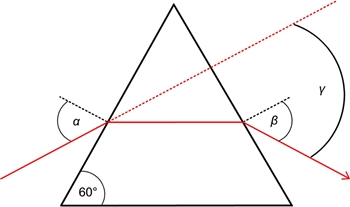
Click to Enlarge
The diagram above shows the relationship between the angle of minimum deviation and the light entering the prism.
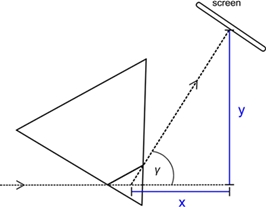
Click to Enlarge
A diagram showing how the angle of minimum deviation can be measured using the educational spectrometer kit.

Click to Enlarge
Figure 1: Scanning Spectrometer with Czerny-Turner Configuration
The EDU-SPEBCT1(/M) Czerny-Turner Extension Kit includes additional components that, in combination with parts from the EDU-SPEB2(/M) Educational Spectrometer Kit, allow the user to build a scanning spectrometer with Czerny-Turner geometry.
Using the setup shown in Figure 1, the light source can be sharply imaged onto the entry slit and then collimated onto the grating by a concave mirror. The grating is mounted on a rotation stage, which allows the angle of incidence to be changed. The diffracted light from the grating is focused onto the exit slit by a second concave mirror. A lens focuses the light that passes the exit slit onto a photodiode detector, and the voltage on the photodiode is measured by a multimeter. The small screen located between the entry and exit slit is used to block stray light from reaching the mirrors.
This setup constitutes a monochromator. Due to the light diffracting on the grating, only a small wavelength range passes the exit slit, and the center wavelength is chosen by the rotation of the grating. Spectra can be acquired pointwise by recording the photodiode voltage for different grating rotation angles.
Grating Equation for Rotatable Grating
The grating diffraction equation for an angle of incidence, α, and an angle of deflection, β, is

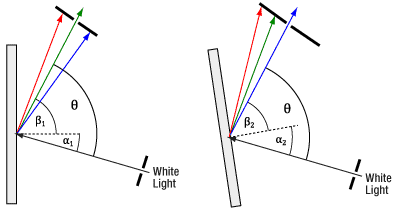
Click to Enlarge
Figure 2: As the rotation angle changes, the wavelength from the first order diffraction that passes through the exit slit changes. The dotted line indicates the grating normal.
where k is the diffraction order, λ is the wavelegth, and g is the groove density of the grating.
Figure 2 shows the first order of diffraction for two different grating rotation angles. As the rest of the setup is fixed, the angle θ between the incident light and the direction of the light that passes the exit slit is constant while α and β change, resulting in different wavelengths passing the exit slit. A calibration procedure is used to determine θ, and the rotation stage is zeroed so that the displayed angle is equal to the angle of incidence α. Then, the following equation links the rotation angle of the grating to the wavelength passing the exit slit:

Acquiring Spectra
The intensity spectrum of a light source is acquired by rotating the grating in small fixed steps and recording the voltage on the photodiode for each step. For absorption spectroscopy of a solid or liquid sample, two spectra are taken; this includes a reference spectrum without the sample and a sample spectrum with the sample inserted in the beam path. The transmission spectrum of the sample can be determined by dividing the sample spectrum by the reference spectrum. Figure 3 shows the reference (blue) and sample (red) spectra for an example measurement made with the FGB67 filter that is included in the Czerny-Turner Extension kit as a test sample. Figure 4 shows the resulting transmission spectrum of the filter recorded with the educational kit and with a commercial spectrometer.

Click to Enlarge
Figure 3: Reference (blue) and sample (red) spectra recorded with the the Czerny-Turner setup. The LEDW7E white LED is used as the light source and the FGB67 filter is used as the sample.
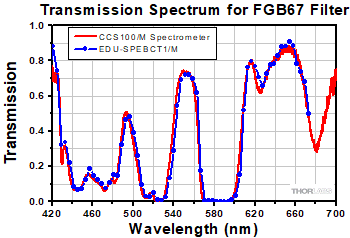
Click to Enlarge
Figure 4: Transmission through the FGB67 filter recorded using the Czerny-Turner setup and the CCS100/M spectrometer. For the EDU-SPEBCT1/M kit measurement, the reference and sample spectra are shown in Figure 3.
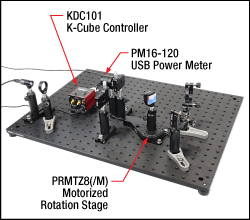
Click to Enlarge This picture shows the automated version of the Czerny-Turner Extension kit. The arrows point out the parts that need to be exchanged or added to create the automated version of this kit.
Automating the Educational Spectrometer Kit
The EDU-SPEB2(/M) Educational Spectrometer Kit with the EDU-SPEBCT1(/M) Czerny-Turner Extension Kit's rotation stage can be automated to speed up scanning spectroscopy measurements. Another benefit of automating your kit is that the automated stages can allow for smaller step sizes, which increases the spectral resolution.
To automate your kit, we suggest substituting the PR01(/M) manual rotation stage and the SM05PD1A photodiode with the PRMTZ8(/M) rotation stage and the PM16-120 compact USB power meter, respectively. Additionally, a KDC101 controller is required to control the stage. The PRMTZ8(/M) rotation stage has a minimum step size of 2.4 arcmin compared to the 5 arcmin resolution of the standard stage in the Czerny-Turner Extension Kit. The automated setup is shown in the image to the right.
To synchronize the rotation angle with the intensity data, a bit of software is required. We have written two LabVIEW-based scripts for our suggested setup, one for large-wavelength-range measurements and one for high-resolution measurements. We are happy to share these with you; to access these scripts please email europe@thorlabs.com.
The main advantages of automating this kit are faster measurements and better resolution, as compared to the EDU-SPEBCT1 kit alone. In the lower left graph, the spectrometer kit with the automated Czerny-Turner extension shows similar performance to Thorlabs' CCS100(/M) compact CCD spectrometer when measuring the absorption spectrum of a multi-bandpass filter. This measurement was recorded in less than three minutes which is significantly faster than the educational spectrometer kit alone. When limiting the spectral range of the measurement, the spectral resolution (i.e., the distance at which two spectral lines are observed individually) of the automated kit is better than
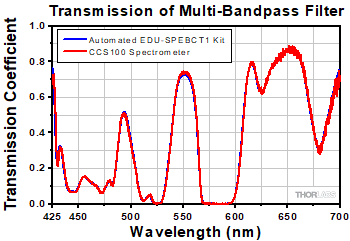
Click to Enlarge
The automated spectrometer kit shows similar performance to the our CCS100(/M) CCD Spectometer.

Click to Enlarge
The graph above shows the spectrum of a sodium vapor lamp taken with the automated spectrometer kit and is evidence that the spectral resolution is better than 0.6 nm. The literature values of the sodium D-lines are 588.95 nm and 589.592 nm.
Thorlabs' spectrometer kits have been carefully engineered to be easy to set up and to give clear, reliable results. These kits are built using stock Thorlabs components, making it possible to expand the scope of the experiment by purchasing additional components. A list of components for each kit can be found below:
Spectrometer Kit Components
Light Sources Note: The LEDW7E white LED is included in this spectrometer kit together with a bandpass filter. This combination enables investigation of a spectrally broad light source as well as a narrow spectral line. Many other light sources including LEDs, lasers, gas discharge tubes, and light bulbs can be analyzed. If you would like to use a lamp with the spectrometer, the QTH10 Quartz Tungsten-Halogen Lamp provides a compact, economical option. The lamp's 10 W bulb has a lower intensity than the LEDW7E LED, but still produces a detectable spectrum.
Diffraction Gratings Handling Warning: Optical gratings can be easily damaged by moisture, fingerprints, aerosols, or the slightest contact with any abrasive material. Gratings should only be handled when necessary and always held by the sides. Latex gloves or a similar protective covering should be worn to prevent oil from fingers from reaching the grating surface. No attempt should be made to clean a grating other than blowing off dust with clean, dry air or nitrogen. Solvents will likely damage the grating's surface.
Purchasing Note: Both the imperial and metric versions of the kit include the English manual. For the metric kits, a German language manual will be added based on your shipping location. Please contact Tech Support if you would like the German manual included with the imperial version of the kit.
Specials: We are happy to provide alternative versions of this kit, such as a reduced version which includes only the parts that are required to build a basic spectrometer. Please contact our Technical Support with inquiries.
The spectrometer kit is offered in both an imperial (EDU-SPEB2) and a metric version (EDU-SPEB2/M). For components listed in the table to the right that have a different part number in the imperial and metric kits, the metric part number and dimensions are indicated by parentheses. This kit can be configured as either a grating- or prism-based spectrometer, and it includes diffraction gratings with two different groove densities and an equilateral dispersing prism.

| EDU-SPEB2(/M) Kit Componentsa | ||
|---|---|---|
| Item # | Description | Qty. |
| LEDMT1F | LED Mount | 1 |
| LEDW7E | White LED, Pkg. of 5 | 1 |
| SMR05 (SMR05/M) | Lens Mount without Retaining Lip for Ø1/2" Optics | 1 |
| SM05L03 | SM05 Lens Tube, 0.30" Thread Depth | 2 |
| DS5 | 5 VDC USB Power Supply | 1 |
| LB1471 | Ø1" Bi-Convex Lens, f = 50 mm | 1 |
| LB1676 | Ø1" Bi-Convex Lens, f = 100 mm | 1 |
| LMR1 (LMR1/M) | Ø1" Lens Mount with Retaining Ring | 2 |
| - | Ø1/2" Bandpass Filter, 532 ± 0.6 nm CWL, 3 ± 0.6 nm FWHM | 1 |
| VA100 (VA100/M) | Adjustable Slit | 1 |
| GR25-0605 | 600 lines/mm Reflective Diffraction Grating | 1 |
| GR25-1205 | 1200 lines/mm Reflective Diffraction Grating | 1 |
| KMSR (KMSR/M) | Kinematic Mount for 1" Rectangular Optics | 2 |
| PS858 | Equilateral Dispersing Prism, 20 mm | 1 |
| KM100PM (KM100PM/M) |
Kinematic Prism Mount | 1 |
| PM3 (PM3/M) | Clamping Arm for Prism Mount | 1 |
| EDU-VS1 (EDU-VS1/M) |
Viewing Screen | 1 |
| MB1824 (MB4560/M) | Optical Breadboard, 18" x 24" (45 cm x 60 cm) | 1 |
| RDF1 | Rubber Damping Feet, Set of 4 | 4 |
| PH3 (PH75/M) | Ø1/2" (Ø12.7 mm) Post Holder, 3" (75 mm) Long | 7 |
| TR3 (TR75/M) | Ø1/2" (Ø12.7 mm) Optical Post, 3" (75 mm) Long | 7 |
| PH2 (PH50/M) | Ø1/2" (Ø12.7 mm) Post Holder, 2" (50 mm) Long | 1 |
| TR2 (TR50/M) | Ø1/2" (Ø12.7 mm) Optical Post, 2" (50 mm) Long | 1 |
| BA1 (BA1/M) | Post Holder Base, 1" x 3" x 3/8" (25 mm x 75 mm x 10 mm) | 3 |
| BA2 (BA2/M) | Post Holder Base, 2" x 3" x 3/8" (50 mm x 75 mm x 10 mm) | 3 |
| BE1 (BE1/M) | Ø1.25" (Ø31.8 mm) Pedestal Base Adapter | 2 |
| CF125 | Clamping Fork | 2 |
| TPS5 | Laser Safety Screen, 12" x 12" (305 mm x 305 mm) | 1 |
| USB-C-72 | 72" USB 2.0 Type-A Extension Cable | 1 |
| SPW603 | Spanner Wrench for SM05 Retaining Rings, 1" Long | 1 |
| SPW606 | Spanner Wrench for SM1 Retaining Rings, 1" Long | 1 |
Imperial Kit: Included Hardware and Screws
| Item # | Description | Qty. |
|---|---|---|
| SH8S025a | 8-32 x 1/4" Long Cap Screw | 1 |
| SH25S038b | 1/4"-20 x 3/8" Long Cap Screw | 10 |
| SH25S050b | 1/4"-20 x 1/2" Long Cap Screw | 4 |
| SH25S063b | 1/4"-20 x 5/8" Long Cap Screw | 6 |
| W25S050c | 1/4" Washer | 10 |
| BD-3/16L | 1/4"-20 Ball Driver | 1 |
| - | 5/64" Hex Key | 1 |
| - | 9/64" Hex Key | 1 |
Metric Kit: Included Hardware and Screws
| Item # | Description | Qty. |
|---|---|---|
| SH4MS06a | M4 x 6 mm Long Cap Screw | 1 |
| SH6MS10b | M6 x 10 mm Long Cap Screw | 10 |
| SH6MS12b | M6 x 12 mm Long Cap Screw | 4 |
| SH6MS16b | M6 x 16 mm Long Cap Screw | 6 |
| W25S050c | M6 Washer | 10 |
| BD-5ML | M6 Ball Driver | 1 |
| - | 2.0 mm Hex Key | 1 |
| - | 3.0 mm Hex Key | 1 |
Czerny-Turner Extension Kit Components
Thorlabs' Czerny-Turner Extension Kit is built using stock Thorlabs components and is offered in both an imperial (EDU-SPEBCT1) and a metric version (EDU-SPEBCT1/M). For components listed in the tables below that have a different part number in the imperial and metric kits, the metric part number and dimensions are indicated by parentheses.

|
EDU-SPEBCT1(/M) Kit Components
|
||
|---|---|---|
| Item # | Description | Qty. |
| PH2 (PH50/M) | Ø1/2 (Ø12.7 mm) Post Holder, 2" (50 mm) Long | 2 |
| TR2 (TR50/M) | Ø1/2" (Ø12.7 mm) Post, 2" (50 mm) Long | 2 |
| PH3 (PH75/M) | Ø1/2" (Ø12.7 mm) Post Holder, 3" (75 mm) Long | 2 |
| TR3 (TR75/M) | Ø1/2" (Ø12.7 mm) Post, 3" (75 mm) Long | 4 |
| UPH3 (UPH75/M) | Ø1/2" (Ø12.7 mm) Universal Post Holder, 3" (75 mm) | 2 |
| BE1 (BE1/M) | Ø1.25" (Ø31.8 mm) Pedestal Base Adapter | 3 |
| CF125 | Clamping Fork | 2 |
| KCP05 (KCP05/M) | Centering Plate for Kinematic Mirror Mount for Ø1/2" Optics | 1 |
| PR01 (PR01/M) | High-Precision Rotation Mount | 1 |
| PR01A (PR01A/M) | Solid Adapter Plate for PR01(/M) | 1 |
| EDU-VS2 (EDU-VS2/M) | Small Viewing Screen | 1 |
| R2 (R2/M) | Slip-On Post Collar for Ø1/2" Posts | 1 |
| LB1757 | Ø1" Bi-Convex Lens, f = 30 mm | 1 |
| LMR1 (LMR1/M) | Ø1" Lens Mount with Retaining Ring | 1 |
| CM254-200-P01 | Ø1" Silver-Coated Concave Mirror, f = 200 mm | 2 |
| KM100 | Kinematic Mirror Mount for Ø1" Optics | 2 |
| KCP1 (KCP1/M) | Centering Plate for Kinematic Mirror Mount for Ø1" Optics | 2 |
| VA100 (VA100/M) | Adjustable Mechanical Slit | 1 |
| FGB67a | Ø25 mm BG36 Glass Bandpass Filter | 1 |
| SM1A1 | Adapter with External SM05 Threads and Internal SM1 Threads | 1 |
| SM1RR | SM1 Retaining Ring for Ø1" Lens Tubes and Mounts | 1 |
| SM05PD1A | Silicon Photodiode, 350-1100 nm | 1 |
| SM05M10 | SM05 Lens Tube Without External Threads, 1" Long | 1 |
| SM05L05 | SM05 Lens Tube, 0.50" Thread Depth | 1 |
| SM05A3 | Adapter with External SM05 Threads and External SM1 Threads | 1 |
| CA2812 | SMA Coaxial Cable, SMA Male to BNC Male, 12" (304 mm) | 1 |
| T3285 | BNC Adapter, T, Female-Male-Female (F-M-F) | 1 |
| T4003 | BNC Adapter, Female to Banana Plug | 1 |
| FT104 | 100 kΩ Fixed Stub-Style BNC Terminato | 1 |
| DVM1 | 10-Function Digital Multimeter | 1 |
Imperial Kit: Included Hardware and Screws
| Item # | Description | Qty. |
|---|---|---|
| SH8S025a | 8-32 x 1/4" Long Cap Screw | 3 |
| SH25S038b | 1/4"-20 x 3/8" Long Cap Screw | 4 |
| SH25S063b | 1/4"-20 x 5/8" Long Cap Screw | 2 |
| SS25S050b | 1/4"-20 x 1/2" Long Setscrew | 1 |
| W25S050c | 1/4" Washer | 6 |
| BD-5/64 | 5/64" Balldriver | 1 |
| - | 3/32" Hex Key | 1 |
| - | 5/64" Hex Key | 1 |
| - | 9/64" Hex Key | 1 |
Metric Kit: Included Hardware and Screws
| Item # | Description | Qty. |
|---|---|---|
| SH4MS06a | M4 x 6 mm Long Cap Screw | 3 |
| SH6MS10b | M6 x 10 mm Long Cap Screw | 4 |
| SH6MS16b | M6 x 16 mm Long Cap Screw | 2 |
| SS6MS12b | M6 x 12 mm Long Setscrew | 1 |
| W25S050c | M6 Washer | 6 |
| BD-2M | 2 mm Balldriver | 1 |
| - | 3/32" Hex Key | 1 |
| - | 2 mm Hex Key | 1 |
| - | 3 mm Hex Key | 1 |
We cordially thank Antje Bergmann and Stefan Reich (Karlsruhe Institute of Technology) for sharing their design for an educational spectrometer.
Do you have ideas for an experiment that you would like to see implemented in an educational kit? Contact us at techsupport@thorlabs.com; we'd love to hear from you.
| Posted Comments: | |
| No Comments Posted |

- Includes All Components to Build a Grating-Based Spectrometer
- Wavelength-Dispersive Elements: 600 lines/mm and 1200 lines/mm Reflective Gratings
- Includes All Components to Build a Prism-Based Spectrometer
- Wavelength-Dispersive Element: Equilateral Prism
- Determine the Spectral Composition of the Included White LED or User-Provided Light Sources
Thorlabs' EDU-SPEB2(/M) Spectrometer Educational Kit includes the components to build a grating-based or prism-based spectrometer. This educational kit is offered in both an imperial and metric version.
For the grating-based spectometer, a reflecting grating (blazed) of either 600 lines/mm or 1200 lines/mm functions as the wavelength dispersive element, while the prism-based spectrometer utilizies a dispersive equilateral prism. A broadband white LED is included as the light source, and a bandpass filter is provided to produce a narrow spectral line; see the Kit Components tab for a full list of the included components. The spectrometers built with this kit can achieve fine spectral resolution. For example, this setup can resolve the sodium-D lines, which have a spectra distance of 0.6 nm.
In addition to analyzing the spectral components of a light source, the grating spectrometer demonstrates interference and the wave nature of light, as well as the relationship between slit width and spatial resolution, slit width and intensity, and grating groove density and spatial resolution. The prism spectrometer provides the opportunity to study various ray optics concepts, and can be used to calculate the refractive index of the prism glass. For more details on these two spectrometer configurations, please see the Experiments tab.

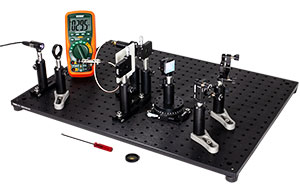
Click to Enlarge
Czerny-Turner Configuration Built with Components from the
EDU-SPEBCT1/M Extension Kit and EDU-SPEB2/M Educational Kit
- Use with EDU-SPEB2(/M) Above to Build a Czerny-Turner Spectrometer
- Includes Two Concave Mirrors Instead of Lenses to Avoid Chromatic Aberrations
- Perform Quantitative Absorption Spectroscopy with a Rotatable Grating Stage, a Second Adjustable Slit, and a Photodiode
- Gain Monochromator Functionality
The EDU-SPEBCT1(/M) Extension Kit contains all of the components needed to convert the
EDU-SPEB2(/M) Educational Spectrometer Kit into a scanning spectrometer with Czerny-Turner geometry, which is commonly used in commercial spectrometers. This extension kit is offered in both an imperial and metric version.
The Czerny-Turner setup includes concave mirrors instead of lenses to avoid chromatic aberrations, a rotatable grating stage and second adjustable slit for monochromator functionality, and a photodiode for quantitative spectroscopy measurements; see the Kit Components tab for a full list of included items. With this kit, students obtain a deeper understanding of the working principles of spectrometers and monochromators, and they have the opportunity to record the spectra of various light sources, as well as perform absorption spectroscopy on solid or liquid samples. This extension kit includes a colored glass filter with multiple bandpasses in the visible regime as a test sample. More information on the Czerny-Turner setup can be found on the Czerny-Turner Add-On tab.
Note: The EDU-SPEBCT1(/M) Czerny-Turner Extension Kit is not a standalone kit; parts from the EDU-SPEB2(/M) Educational Spectrometer Kit (sold above) are required to build a complete Czerny-Turner configuration. Please contact Tech Support if you would like to purchase only the components to build the complete Czerny-Turner configuration.
 Products Home
Products Home













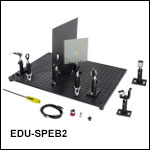
 Zoom
Zoom
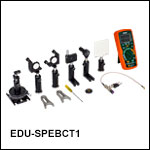
 Spectrometer Kits
Spectrometer Kits